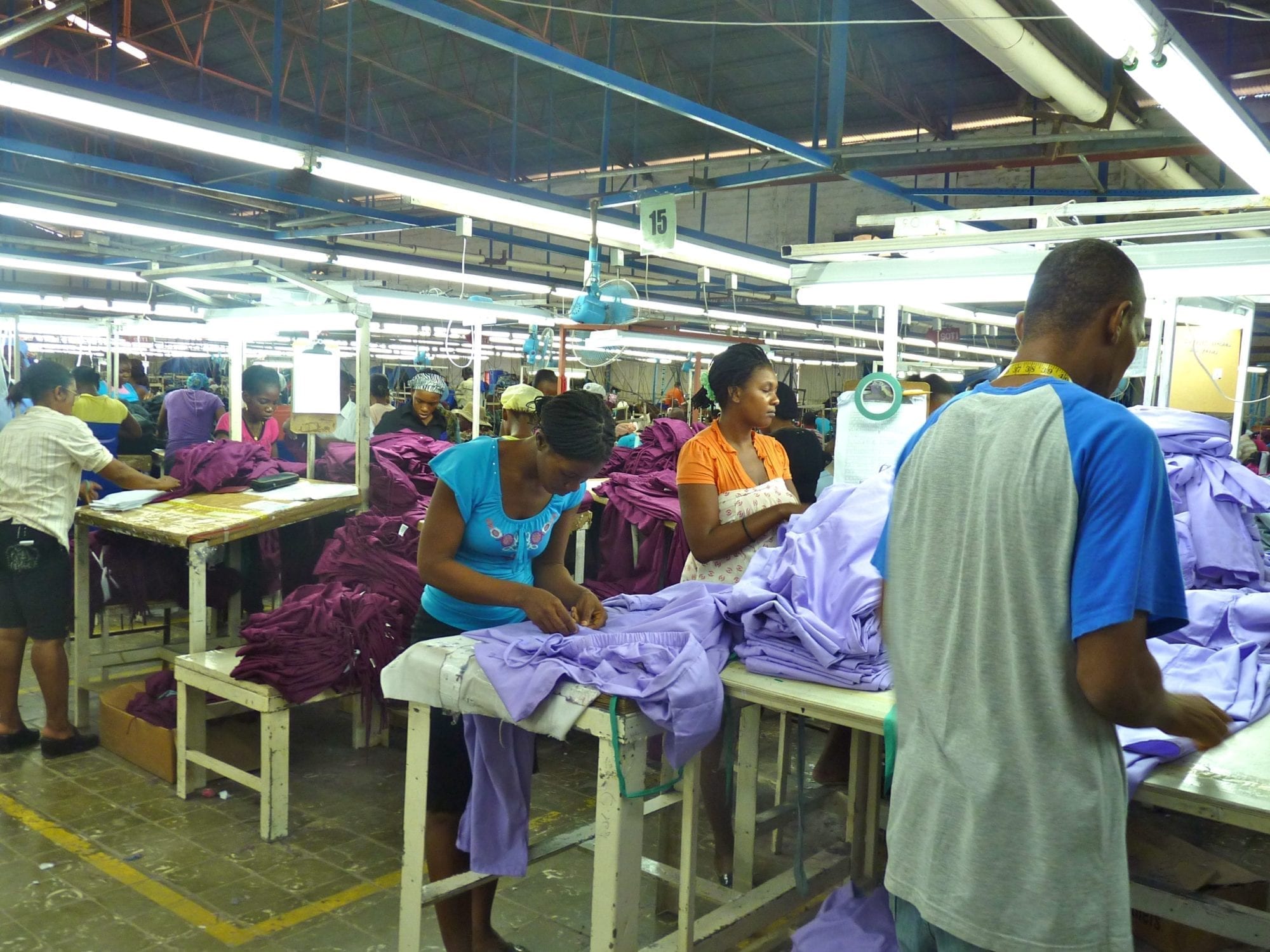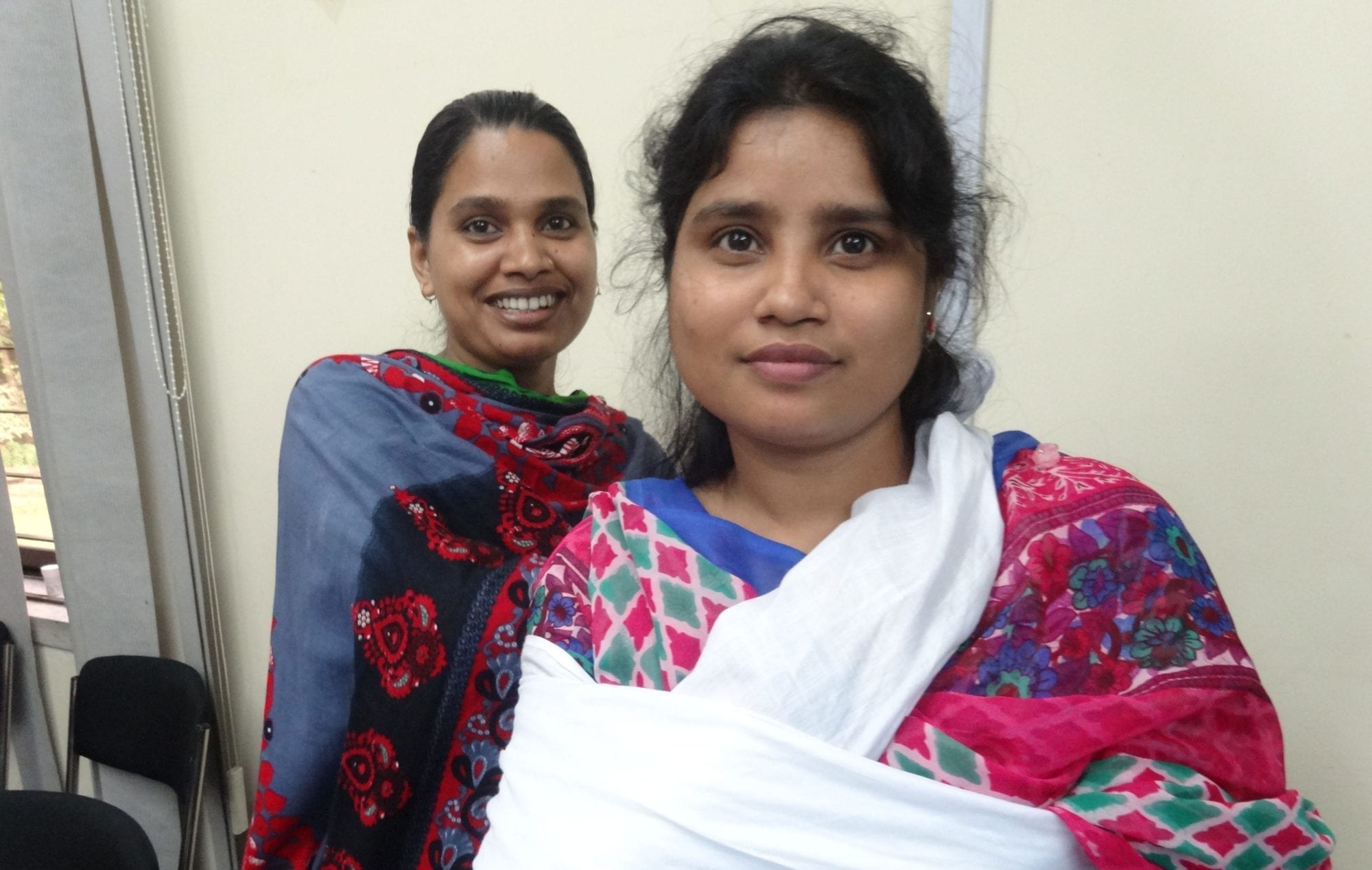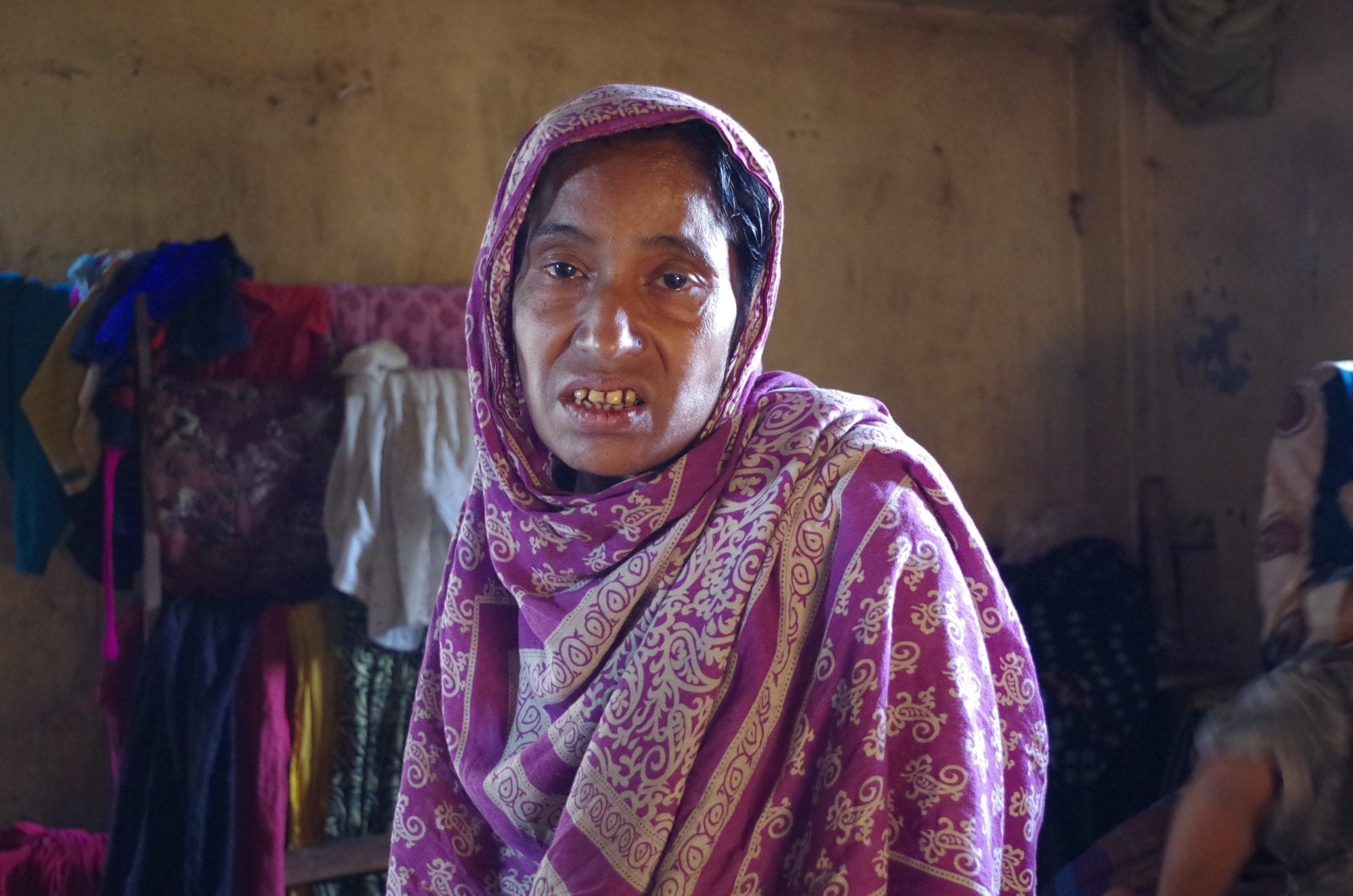
Jan 11, 2016
Six years after a major earthquake devastated the Haitian capital and its environs and the international community promised to “build back better,” Haitian workers say their daily lives are a struggle for survival, with their meager wages insufficient to cover basic expenses.
In recent interviews, Haitian garment workers told the Solidarity Center that they are worse off today than before the quake. With prices rising and wages largely stagnant, their paychecks do not allow them to support themselves and their families.
“We spend almost our entire daily wage on food and transportation,” said one garment worker interviewed. “We cannot save any money and we do not have enough money to get health care or education. Our future is compromised.”
Another worker said he sometimes has to borrow money to “make sure that at least the family has something to eat.”
Haiti is the poorest country in the Western Hemisphere and one of the poorest in the world. According to the World Bank, more than 6 million of Haiti’s 10.4 million people (59 percent) live under the poverty line.
Haitian garment workers hold rare full-time jobs in an economy that is largely informal, and work for profitable multinational manufacturers, some incentivized to come to Haiti and create jobs after the quake. Yet garment-sector wages are legally set below the national minimum wage and well below what is necessary to cover basic costs. A December 2015 Solidarity Center analysis of living expenses found that the average garment worker spends 160–225 Haitian gourdes ($2.80 – $3.94) a day on food and transportation for herself, and another 395 gourdes ($6.91) on food for the household. The current minimum daily wage for garment workers, who work 48 hours a week, is 225–240 gourdes ($3.94–$4.20). The minimum wage is supposed to increase this spring, to $5.11 for an eight-hour shift.
In 2013, Haitian workers and their unions waged rallies and protests to demand that the daily minimum wage be increased to 500 gourdes ($8.75) for export apparel workers. The government set the wage at less than half of that. In 2014, the Solidarity Center found that a living wage of 1,000 gourdes per day would allow workers to meet their basic needs.
“As we mark this grim anniversary, we have to ask why the people best-positioned to revive the Haitian economy—hardworking Haitians—are handicapped by abysmal and degrading wages. Until Haitians can earn a living that allows them to do more than barely survive, there will be no real recovery,” said Shawna Bader-Blau, executive director of the Solidarity Center. “The international community and Haitian government should be ashamed of policies that guarantee poverty wages and grant concessions to multinational corporations instead of providing real opportunities for Haitians workers to improve their lives and livelihoods and build a better country for themselves and their children.”

Nov 19, 2015
Bilkish Begum says she and other workers at a garment factory in Bangladesh could not discuss implementing fire safety measures with their employer—even after the deadly blaze at Tazreen Fashions factory killed 112 workers three years ago next week. Only when they formed a union, which provides workers with protection against retaliation for seeking to improve their workplace conditions, could they take steps to help ensure their safety.
“Things have improved a lot regarding fire safety once we formed union as now we have the power to raise our voice,” she says.
Bilkish, 30, now a leader of a factory union affiliated with the Sommilito Garments Sramik Federation (SGSF), is among hundreds of garment workers who have taken part in Solidarity Center fire safety trainings this year. The Solidarity Center works with garment workers, union leaders and factory management to improve fire safety conditions in Bangladesh’s ready-made garment industry through such hands-on courses as the 10-week Fire and Building Safety Resource Person Certification Training.
“I used to be afraid about fire eruption in my factory,” Bilkish says. “But after attending trainings, I feel that if we work together, we can reduce risk of fire in our factory.”
Fire remains a significant hazard in Bangladesh factories. Since the Tazreen fire, some 34 workers have died and at least 985 workers have been injured in 91 fire incidents, according to data collected by Solidarity Center staff in Dhaka, the capital. Incidents resulting in injuries include at least eight false alarms.
In January, after a short-circuit caused a generator to explode at one garment factory, Osman, president of the factory union and Popi Akter, another union leader, quickly addressed the fire and calmed panicked workers using the skills they learned through the Solidarity Center fire training. They also worked with factory management to correct other safety issues, like blocked aisles and stairwells cramped with flammable material.
Many workers who have taken part in the trainings say they are equipped to handle fire accidents.
“We are now confident after the training that we can help factory management and other workers if there is any incident of fire in our factory,” says Mosammat Doli, 35, a leader of a union affiliated with the Bangladesh Garment and Industrial Workers’ Federation (BGIWF).
“From my experience at my factory, I have seen that an effective trade union can ensure fire safety in the factory as it can raise safety concerns,” he said.
Fewer than 3 percent of the 5,000 garment factories in Bangladesh have a union. And according to the International Labor Organization, 80 percent of Bangladeshi garment factories need to address fire and electrical safety standards. Yet, despite workers’ efforts to form organizations to represent them this year, the Bangladeshi government rejected more than 50 registration applications—many for unfair or arbitrary reasons—while only 61 were successful. This is in stark contrast to only two years ago, when 135 unions applied for registration and the government rejected 25 applications, and to 2014, when 273 unions applied and 66 were rejected.
Without a union, workers often are harassed or fired when they ask their employer to fix workplace safety and health conditions.
Because his workplace has a union, which enabled Doli to participate in fire safety training, he—like Osman and Popi Aktee—already has potentially saved lives. Together with other union leaders, he helped evacuate workers and extinguish a fire in their garment factory.
Shahabuddin, 25, an executive member of his factory union, which is affiliated with SGSF, is among Bangladesh garment workers who see firsthand how unions help ensure safe and healthy working conditions. He says his workplace had no fire safety equipment—until workers formed a union and collectively raised the issue of job safety.
“Now management conducts fire evacuation drills almost regularly. We did not imagine it just a few years back. As we formed union, many things started changing,” he says.
Mushfique Wadud is Solidarity Center communications officer in Bangladesh.

Nov 19, 2015
“You have forgotten the Tazreen fire incident but our actual suffering has just started,” says Anju, who experienced severe head, eye and other bodily injuries during the fatal Tazreen Fashions Ltd. fire in Bangladesh that killed 112 garment workers.
Survivors of the November 24, 2012, Tazreen fire who recently talked with Solidarity Center staff in Bangladesh say they endure daily physical and emotional pain and in many cases, have little or no means of financial support because they cannot work. Some, like Anju, who is unable to work, have never received compensation for their injuries.
Bangladesh’s $25 billion garment industry fuels the country’s economy, with ready-made garments accounting for nearly four-fifths of exports. Yet many of the country’s 4 million garment workers, most of whom are women, still work in dangerous, often deadly conditions. Since the Tazreen fire, some 34 garment workers have died and 985 have been injured in 91 fire incidents, according to data collected by Solidarity Center staff in Dhaka, the capital.
Some 80 percent of export-oriented ready made garment (RMG) factories in Bangladesh need improvement in fire and electrical safety standards, despite a government finding most were safe, according to a recent International Labor Organization (ILO) report.
The Solidarity Center has had an on-the-ground presence in Bangladesh for more than a decade. Through Solidarity Center fire safety trainings for union leaders and workers, garment workers learn to identify and correct problems at their worksites. But fewer than 3 percent of the 5,000 garment factories in Bangladesh have a union. ” Despite workers’ efforts to form unions, in 2015 alone the Bangladeshi government has rejected more than 50 registration applications—many for unfair or arbitrary reasons—while only 61 have been successful. The rejections have jumped significantly from 2014, when 273 unions applied and 66 were rejected.
So that the world does not forget, here is the story of Anju and others who survived the Tazreen fire.
Photos: Solidarity Center/Mushfique Wadud
[portfolio_slideshow id=6745]
Feb 18, 2014
Garment workers and workers in other industries in Bangladesh’s export-processing zones are subject to a different, much weaker set of labor laws than workers in the rest of the country, and the government must take steps to reform laws so they meet international standards for freedom of association and collective bargaining rights, said A. K. M. Nasim, senior legal counselor at the Solidarity Center’s office in Dhaka, the Bangladesh capital. Further, “if we have any half-hearted reform in the legislation, it will mean that the workers will have to continue their struggle for a period of at least a generation to achieve these fundamental rights.”
Speaking at a recent forum in Washington, D.C., Nasim gave an overview of the current labor rights environment for Bangladeshis and provided key recommendations for improving their wages and working conditions.
Some 377,600 workers, the vast majority women, work in eight export-processing zones (EPZs) throughout the country.
Bangladesh derives 20 percent of its income from exports created in the EPZs, which are industrial areas that offer special incentives to foreign investors like low taxes, lax environmental regulations and low labor costs.
Yet while workers outside the EPZs are permitted to form trade unions, EPZ workers must form weaker workers’ welfare associations. Even though the associations have the right to bargain and negotiate agreements with employers, in practice, employers do not let the workers form their associations easily. Leaders of workers’ associations who actively promote the interests of the employees “have been fired from their jobs,” Nasim said. “As a result, most of the workers’ associations in the EPZs remain in existence only on paper.”
Nasim discussed the decision last June by the U.S. government to suspend Bangladesh’s trade benefits based on the country’s chronic and severe labor rights violations. The United States suspended its Generalized System of Preferences (GSP) agreement with Bangladesh after 112 workers were killed in a 2012 fire at the Tazreen garment factory, and more than 1,100 died last April when the Rana Plaza building collapsed. Since the GSP suspension, the Bangladesh government has allowed some 100 unions to register, in contrast with the few unions recognized prior to last year.
The Rana Plaza disaster also led to the Accord on Fire and Building Safety in Bangladesh, a five-year binding agreement between international labor organizations, non-governmental organizations (NGOs) and retailers in the textile industry to maintain minimum safety standards. The tragedies also have generated an increase in NGO involvement, and Nasim urged the NGOs working to improve workplace safety and health to support workers in forming and running unions, and making sure they are sustainable in the long run.
Also speaking at the forum, Solidarity Center Asia Regional Director Tim Ryan showed how the economic and political intersect in the Bangladesh context as described by Nasim.
“Bangladesh is a crucible for the intersection of globalization, the government’s economic policies, how these impact on the development of a democratic culture in civil society, and equitable and just economic growth that benefits workers and their families,” Ryan said. “A voice for workers in this process is absolutely crucial for growing democracy and democratic organizations in Bangladesh.”
The forum, “Strengthening Democratic Practices in Bangladesh: Empowering Workers in Export Processing Zones,” was sponsored by the National Endowment for Democracy and included Zerxes Spencer from the International Forum for Democratic Studies as moderator.
Jan 7, 2014
In a letter to Cambodia Prime Minister H.E. Hun Sen, the AFL-CIO condemned the Cambodian government’s recent and ongoing violence against garment workers. Calling for an immediate end to the violence and for the release of imprisoned union leaders, the AFL-CIO also is demanding “an independent investigation surrounding the killing and assaults of workers” as well as the withdrawal of legal cases against workers and release of imprisoned union leaders.
On January 2, Cambodian trade union leaders were assaulted and arrested and at least four garment workers killed, with many others injured by security forces at the Canadia Special Economic Zone. Workers have been seeking a higher minimum wage in the garment sector, the nation’s most lucrative industry.
Read the full letter.



